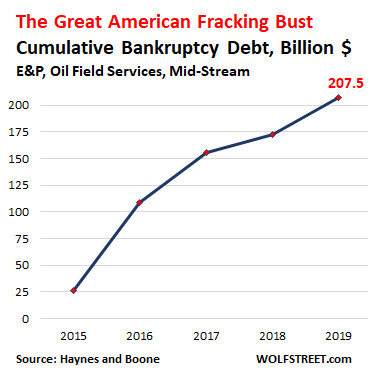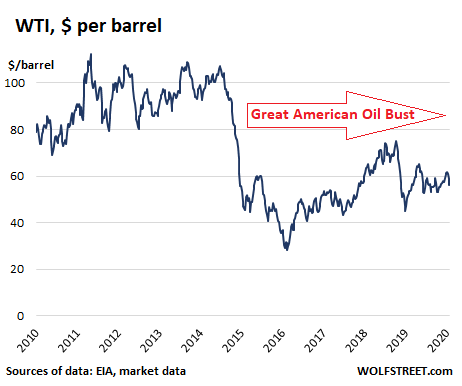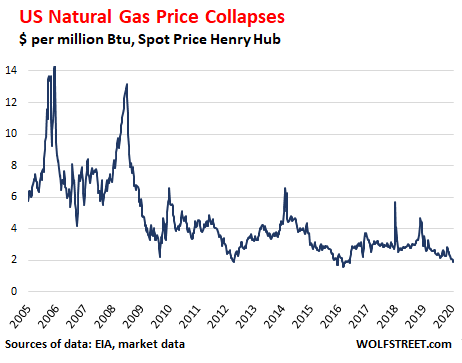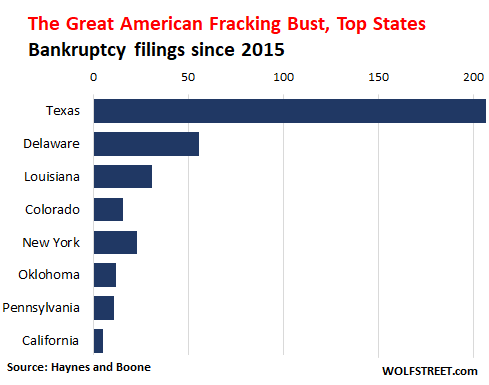The shale boom is over, but not the financial fallout. From Wolf Richter at wolfstreet.com:
Texas at the epicenter. We’re witnessing the destruction of money that loosey-goosey monetary policies encouraged.
Following the sharp re-drop in oil and natural gas prices in late 2018, bankruptcy filings in the US by already weakened exploration and production companies , oilfield services companies, and “midstream” companies (they gather, transport, process, or store oil and natural gas) jumped by 51% in 2019, to 65 filings, according to data compiled by law firm Haynes and Boone. This brought the total of the Great American Shale Oil & Gas Bust since 2015 in these three sectors to 402 bankruptcy filings.
The debt involved in these bankruptcies in 2019 doubled from 2018 to $35 billion. This pushed the total debt listed in these bankruptcy filings since 2015 to $207 billion. The chart below shows the cumulative total debt involved in these bankruptcies since 2015.

But this does not include the much larger losses suffered by shareholders that get mostly wiped out in the years before the bankruptcy as the shares descend into worthlessness, and that then may get finished off in bankruptcy court.
The banks, which generally had the best collateral, took the smallest losses; bondholders took bigger losses, with unsecured bondholders taking the biggest losses. Some of them lost most of their investment; others got high-and-tight haircuts; others held debt that was converted to equity in the restructured companies, some of which soon became worthless again when the company filed for bankruptcy a second time. The old shareholders took the biggest losses.
The Great American Fracking Bust started in mid-2014, when the price of WTI dropped from over $100 a barrel to below $30 a barrel by early 2016. Then the price began to recover, going over $70 a barrel in September and October 2018. But then it began to re-plunge. By the end of 2018, WTI had dropped to $47 a barrel.
Two major geopolitical events in the Middle East – the attack on Saudi Aramco’s oil facilities last September and the US assassination of Iranian Major General Qasem Soleimani – that would have shaken up oil markets before, only caused brief ripples, quickly squashed by the onslaught of surging US production. At the moment, WTI trades at $56.08 per barrel, which is still below where the shale oil industry can survive long-term:

And 2020 is starting out terrible for natural gas producers. The price of natural gas has plunged to $1.90 per million Btu at the moment, a dreadfully low price where no one can make any money. Producers in shale fields that produce mostly gas, such as the Marcellus, are in deeper trouble still, because oil, even at these prices, would be a lot better than just natural gas.
Producing areas with constrained takeaway capacity (it takes a lot longer to build pipelines than to ramp up production) are subject to local prices, which can be lower still. In some areas, such as the Permian in Texas and New Mexico, the most prolific oil field in the US, where natural gas is a byproduct of oil production, limited takeaway capacity has caused local prices to collapse, and flaring to surge.
The chart shows the spot price for delivery at the Henry Hub:

Texas at the epicenter.
The most affected state, in terms of the number of bankruptcy filings, is Texas, the largest oil producer in the US. Since 2015, the state had 207 oil-and-gas bankruptcy filings, of the 402 total US filings. In 2019, Texas had 30 of the 65 US filings.
Delaware, obviously, is not into oil and gas production, but into coddling corporations, and many companies are incorporated in Delaware, including some oil-and-gas companies in Texas. When they file for bankruptcy, they do so in Delaware. These are the eight states with the most oil-and-gas bankruptcy filings since 2015:

Bankruptcy filings are triggered when the E&P companies no longer get funding from Wall Street or from their banks to continue with their perennially cash-flow negative operations and service their debts. And this is what is happening now. Wall Street and the banks have started to demand that these companies stick to an entirely new mantra in the fracking business: “live within cash flow.”
When E&P companies run short on funding, they cut back on drilling activity which puts the squeeze on oilfield services companies that provide products and services to the oilfield, including drilling and completing wells. And then these OFS companies go bankrupt.
This is what happened to oilfield-services giant Weatherford which filed for a prepackaged bankruptcy last July. Back in 2014, before the oil bust, it had 67,000 employees; by July, it was down to about 26,000. The reorganization plan allowed Weatherford to shed $5.8 billion of its $7.6 billion in long-term debt. Old shareholders got wiped out. The creditors got 99% of the restructured company’s new shares.
In its report on the OFS bankruptcies, Haynes and Boone cited this pressure from Wall Street and its cascading effect, which Weatherford had pointed out in its bankruptcy filing:
We note that Weatherford, in its July 2019 filing, attributed its insolvency in part to reduced drilling activity by producers who have also been dramatically affected by the commodity price slump since 2015. Investors’ pressure on producers to “live within cash flow” is further reducing demand for OFS services and supplies leaving the OFS sector with little near term hope for a turnaround in prospects.
What this sector needs are much higher prices for oil and natural gas. But that cannot happen while production continues to surge. A large-scale culling in the sector – a lot more bankruptcies – could reduce production, and support higher prices.
But as soon as prices rise above certain levels, with investors still chasing yield at every twist and turn, the flood of new money will wash over the sector again, with investors having already forgotten by then that shale oil and gas was where money went to die every time. And this new money will cause a new surge in production, which will collapse prices once again. It’s a cycle that the shale industry has a hard time getting out of, under the current loosey-goosey monetary conditions.

1The article linked below presents a much more positive picture. Can they both be true? If not, which one is more correct?
https://www.texaspolicy.com/whats-fueling-our-robust-growth/?utm_campaign=The%20Daily%20Cannon&utm_source=hs_email&utm_medium=email&utm_content=82347861&_hsenc=p2ANqtz-9zccGTWGI4YvozA_I66YDb51eQF2lFfCuASauu34xaumSOVEicjuKon-kYclLQg75KnAA7Bqv8bnD7WF1YhG7lebp65A&_hsmi=82347861
LikeLike
I’ll go with Richter. Ms. White never mentions the debt that has supported so much of shale drilling and fracking. She’s a political animal and she sounds like the political animals who touted the debt-propelled housing boom and the overall economy back in 2006 and 2007. We know how that turned out, and given Richter’s facts and graphs, I’d say shale and fracking have already topped. Political animals are generally not very good financial or economic prognosticators. Time will tell if this time is different.
LikeLike
Thanks Robert. I have asked a few (lower level) folks in the business, and they gave me a story closer to Ms. White. They did not really have a good argument about the backruptsy #s and indebtness of the shale and fracking industry. Trump speaks about how the US is energy self sufficient–I just wonder if he is getting any of the Richterlike data. So put me in the Richter camp but with your concluding caveat, “TWTITTID”.
LikeLike
Pingback: The Great American Shale Oil and Gas Bust: Fracking Gushes Bankruptcies, Defaulted Debt, and Worthless Shares, by Wolf Richter — STRAIGHT LINE LOGIC | huggers.ca